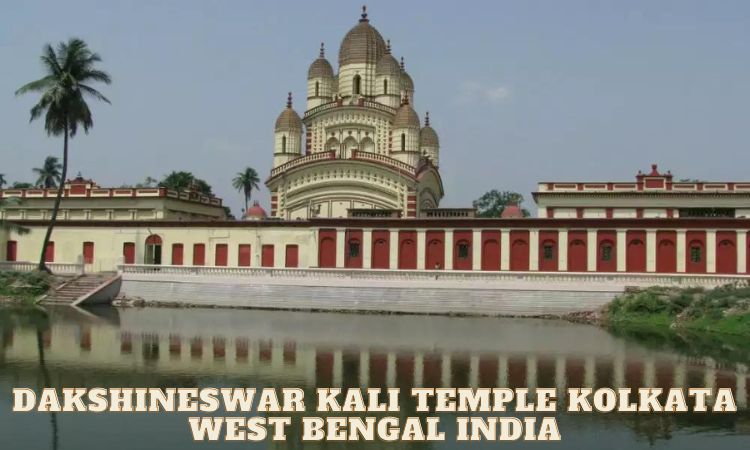
Dakshineswar Kali Temple, nestled on the serene banks of the Hooghly River in Kolkata, West Bengal, India, is a pilgrimage site that transcends religious boundaries. This magnificent temple, a testament to architectural brilliance and spiritual fervor, draws millions of devotees and tourists each year. Its allure lies not only in its stunning architecture but also in its profound association with Ramakrishna Paramahansa, a revered spiritual figure whose teachings continue to inspire seekers worldwide.
A Glimpse into History:
The genesis of Dakshineswar Kali Temple Kolkata West Bengal India can be traced back to the 19th century when Rani Rashmoni, a wealthy and pious Zamindar (landlord), envisioned a grand temple dedicated to Goddess Kali. Driven by a deep spiritual yearning, she embarked on an ambitious project, acquiring vast tracts of land along the Hooghly River. Construction commenced in 1847 and culminated in 1855 with the consecration of the main temple.
Dakshineswar Kali Temple Kolkata West Bengal India Timing
- Morning: 6:00 AM to 1:00 PM
- Evening: 4:00 PM to 9:00 PM
Architectural Marvel:
The temple complex is a masterpiece of Bengal architecture, boasting a unique blend of traditional and contemporary styles. The centerpiece is the main Kali temple, a three-storied structure adorned with intricate carvings and sculptures. Its distinctive feature is the “navaratna” style, characterized by nine spires that crown the edifice. The temple’s grandeur is further enhanced by its surrounding structures, including twelve Shiva temples and a Radha-Krishna temple, all meticulously designed and embellished.
The Divine Presence: Bhavatarini
The presiding deity of Dakshineswar, Bhavatarini, is a unique form of Goddess Kali. Unlike the fearsome depictions often associated with Kali, Bhavatarini exudes a serene and compassionate aura. She stands on the chest of Lord Shiva, symbolizing the dance of creation and destruction, the interplay of opposites that governs the universe. Devotees flock to the temple to seek blessings from Bhavatarini, believing in her power to grant liberation from the cycle of birth and death.
The Ramakrishna Connection:
Dakshineswar’s significance transcends its architectural beauty. It is inextricably linked to the life and teachings of Ramakrishna Paramahansa, a mystic who served as the temple’s priest for several years. Ramakrishna’s profound spiritual experiences, including his visions of the Divine Mother, have made Dakshineswar a hallowed ground for seekers of truth. His teachings, which emphasized the unity of all religions and the importance of selfless service, continue to resonate with people across the globe.
A Day at Dakshineswar:
A visit to Dakshineswar Kali Temple Kolkata West Bengal India is a journey into the heart of spirituality. As one approaches the temple complex, a sense of tranquility pervades the air. The rhythmic chanting of mantras, the aroma of incense, and the serene flow of the Hooghly River create an atmosphere of spiritual upliftment.
The main temple, with its ornate facade and vibrant colors, is a sight to behold. Devotees queue patiently to offer prayers and seek blessings from Bhavatarini. The air is thick with devotion as people offer flowers, fruits, and sweets to the Goddess. The sight of devotees prostrating before the deity, their faces etched with reverence, is a poignant reminder of the power of faith.
Beyond the main temple, the complex offers a wealth of attractions. The twelve Shiva temples, each dedicated to a different aspect of Shiva, are architectural marvels. The Radha-Krishna temple, with its delicate carvings and serene ambiance, is a haven for those seeking solace and inner peace.
A Spiritual Retreat:
Dakshineswar is not merely a tourist destination; it is a spiritual retreat. The temple complex offers a serene environment for introspection and meditation. The lush gardens, the tranquil ponds, and the soothing sounds of the river create an atmosphere conducive to inner peace. Many visitors spend hours in contemplation, seeking solace and spiritual guidance within the sacred precincts of the temple.
Beyond the Temple Walls:
Dakshineswar’s influence extends beyond the temple complex. The town itself has a rich cultural heritage, with numerous temples, ashrams, and cultural centers. The Ramakrishna Math and Mission, established by Ramakrishna’s disciples, is a prominent institution that carries forward his legacy of service and spiritual upliftment.
A Symbol of Unity:
Dakshineswar Kali Temple Kolkata West Bengal India stands as a symbol of unity and harmony. It transcends religious boundaries, welcoming people from all walks of life. Its message of love, compassion, and universal brotherhood resonates with seekers of truth, irrespective of their faith or background.
How to reach Dakshineswar Kali Temple Kolkata West Bengal India?
Here are the main ways to reach Dakshineswar Kali Temple Kolkata West Bengal India:
-
By Train:
- The nearest railway station is Dakshineswar Railway Station.
- You can take a train from Sealdah station in Kolkata to Dakshineswar.
- The temple is within walking distance from the station.
-
By Metro:
- The nearest metro station is Shyambazar.
- From Shyambazar, you can take a taxi or auto-rickshaw to reach the temple.
-
By Bus:
- Several buses ply between Kolkata and Dakshineswar.
- You can find bus stops near the temple.
-
By Taxi/Cab:
- You can easily hire a taxi or cab from any part of Kolkata to reach the temple.
- App-based cab services like Ola and Uber are also readily available.
-
By Ferry:
- For a scenic experience, you can take a ferry across the Hooghly River from Belur Math to Dakshineswar.
Tips for Reaching the Temple:
- Traffic: Be prepared for traffic, especially during peak hours.
- Pre-book: If traveling by taxi or cab, it’s advisable to book in advance, especially during weekends and holidays.
- Local Transport: If using local transport, inquire about the best routes and timings with locals.
Conclusion:
A visit to Dakshineswar Kali Temple Kolkata West Bengal India is an enriching experience that leaves an indelible mark on the soul. It is a journey into the heart of spirituality, a pilgrimage that connects one to the divine. Whether you are a devout follower or a curious traveler, Dakshineswar offers a unique blend of history, culture, and spirituality that is sure to captivate your senses and nourish your soul.
FAQs on Dakshineswar Kali Temple, Kolkata, West Bengal, India
1. What is the Dakshineswar Kali Temple?
Ans. The Dakshineswar Kali Temple is a renowned Hindu temple dedicated to the goddess Kali, located in Kolkata, West Bengal, India. Built in 1855, it’s known for its stunning architecture, association with Ramakrishna Paramahamsa, and being a vibrant center of worship.
2. Who built the Dakshineswar Kali Temple?
Ans. Rani Rashmoni, a philanthropist and ardent devotee of Kali, commissioned the temple’s construction.
3. What is the architectural style of the temple?
Ans. The main temple is built in the Navaratna style, characterized by its nine spires and intricate carvings. The complex also features influences of Bengali chala and other regional styles.
4. Why is Ramakrishna Paramahamsa associated with the temple?
Ans. Ramakrishna served as a priest at the temple for over 30 years. The temple environment played a significant role in his spiritual growth and teachings.
5. What are the daily rituals at the temple?
Ans. The temple follows a strict schedule of pujas (worship ceremonies) dedicated to Kali, including Mangala Aarti (morning awakening) and other pujas throughout the day.
6. What are some major festivals celebrated at the temple?
Ans. Kali Puja is the most prominent festival, but others include Janmashtami (Krishna’s birthday), Rathayatra (chariot festival), and Durga Puja.
7. Is there a dress code for visiting the temple?
Ans. There’s no strict code, but modest clothing covering shoulders and knees is recommended. Shoes must be removed before entering the sanctum sanctorum.
8. Can I take photographs inside the temple?
Ans. Photography within the sanctum sanctorum is often not permitted. It’s best to check with the temple authorities.
9. What are the timings for visiting the temple?
Ans. Timings can vary. It’s generally open from 6:00 AM to 12:30 PM and 3:30 PM to 7:30 PM. Check the official website or call for current timings.
10. How can I reach the Dakshineswar Kali Temple?
Ans. The temple is accessible by local trains, buses, and taxis from Kolkata.


